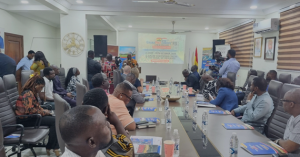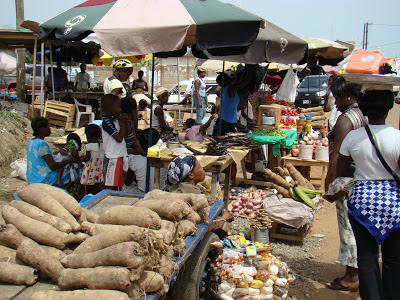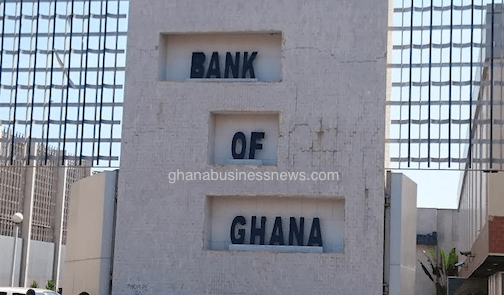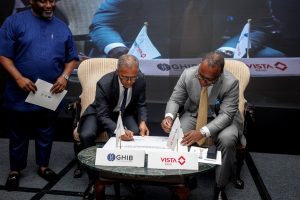
By Kingsley Webora TANKEH
The Chief Executive Officer-Ghana National Chamber of Commerce and Industry (GNCCI), Mark Badu-Aboagye, has urged the Bank of Ghana to aggressively lower its policy rate to end the year at 20 percent, citing anchored inflation expectations and relative macroeconomic stability the country is enjoying.
He argued that the current 25 percent rate stifles business growth and exacerbates inflationary pressures despite recent declines.

Speaking at the launch of GhanaFest Europe ’25 in Accra, Mr. Badu-Aboagye argued that the impact of rate cuts is delayed but essential for long-term stability.
“On average it takes two years for it to affect other macroeconomic variables, especially inflation,” he said, confronting fears that a radical approach to the policy rate could derail gains chalked up so far.
“The inflation reduction we are enjoying now is the result of policy rate hikes we did years back,” he added.
He maintained that cutting the policy rate by 500 basis points to 20 percent would take “about three quarters” to impact inflation but would immediately “strengthen our economy, build a very strong productive capacity to be enabled in reducing inflation”.
“I am not in support that they should keep the policy rate very high,” he emphasised. “We have the room to ease monetary policy in support of fiscal policies on the day-to-day economy.”
The Bank of Ghana (BoG) Monetary Policy Committee made an unprecedented cut in the policy rate by 300 basis points, reducing it from 28 percent to 25 percent, at its July session. Though laudable, as it is the biggest cut since September 2024 when it slashed the rate by 200 basis points, the business community still struggles with inhibitive cost of credit.
Therefore, they anticipate further cuts to improve access to finance as inflation continues on a nose-dive. Inflation has been easing since beginning of the year, having plummeted from 23.5 percent recorded in January to 12.1 percent for July 2025.
However, lending rates remained elevated – with the Ghana Reference Rate (GRR) hovering around 23.80 percent for most loan categories. According to the latest Annualised Percentage Rate (APR) data from the Bank of Ghana, there are sharp disparities across borrower categories and loan maturities. Even households enjoy access to more competitive rates than small- and medium-sized enterprises (SMEs).
Some banks offer APRs around 20 percent for certain tenors while others charge above 40 percent. SMEs face a high floor for borrowing – with even the most competitive one-year SME loans priced above 17 percent and medium-term rates often exceeding 30 percent.
Mr. Badu-Aboagye emphasised that cheaper borrowing costs is critical for Ghanaian businesses as they struggle to navigate US tariff hikes and seek new markets in Europe and other African countries.
“Looking at the dynamics, a 3 percent reduction is very huge – but a 25 percent policy rate is still high,” he lamented. He countered the central bank’s conservative posture, arguing that the current economic fundamentals, as compelling as they are, support further easing of the BoG rate.
He maintains that the sustained decline in inflation, strong reserves and fortified cedi create headroom. “This is a great opportunity for the central bank to also ease monetary policy,” he asserted.
He stressed that the prevailing high borrowing costs prevent businesses from expanding operations and investing in new markets crucial for export diversification away from US tariffs, which according to him has a bearing on job creation.
Further challenging the view that lowering rates would fuel inflation, he argued that much of Ghana’s inflation is “cost-push”. High interest rates directly increase production costs. “If you are reducing the interest rate, it means you are reducing the cost of production as well. And then inflation will come down.”
Mr. Badu-Aboagye is also pushing for Ghanaian businesses to pivot their exports toward Europe and take advantage of the GhanaFest Europe ’25 in the wake of punitive US tariffs. According to him, this shift – moving beyond traditional exports like cocoa, gold and oil – would create opportunities to innovate, diversify, grow and create jobs. However, this requires SME investment – which could be facilitated with lower lending rates.
He expressed the Chamber’s commitment in supporting Ghanaian SMEs to access markets and grow. “A lot of export promotion, a lot of market access… that is the platform we are creating. I would just encourage the business community to collaborate with GNCCI to access European markets.”
Echoing sentiments of needing a pivot to Europe, the General Manager-Ghana Netherlands Business & Culture Council (GNBCC), Ms. Hilde Famaey, threw a challenge to Ghanaian businesses and government officials: “Use GhanaFest Europe ’25 not just to showcase products, but also present investment-ready projects. Come prepared, the GNBCC is here to be your bridge to Dutch capital, technology and expertise”. She positioned the October event as a “curated opportunity gateway” to Ghanaian potential for Dutch businesses.
The Director of Diaspora Affairs at the Office of the President, Mr. Kofi Okyere Darko, stressed that GhanaFest Europe ’25 is a “platform to promote bilateral trade and investment”, leveraging Ghana’s proximity to Europe and the EU’s Economic Partnership Agreement for sectors like agriculture, pharmaceuticals, ICT and logistics.
GhanaFest Europe ’25 is a trade and culture expo organised by RAM Media Concepts in collaboration with the Royal Netherlands Embassy. It will take place at the Amare Convention Centre in the Hague between October 23 – 25, 2025. Activities at the expo will include a B2B conference, exhibition, durbar, art exhibition, culture, music, fashion and food.
The post Microeconomic indicators support 5% policy rate cut before year-end – GNCCI CEO appeared first on The Business & Financial Times.
Read Full Story

















Facebook
Twitter
Pinterest
Instagram
Google+
YouTube
LinkedIn
RSS